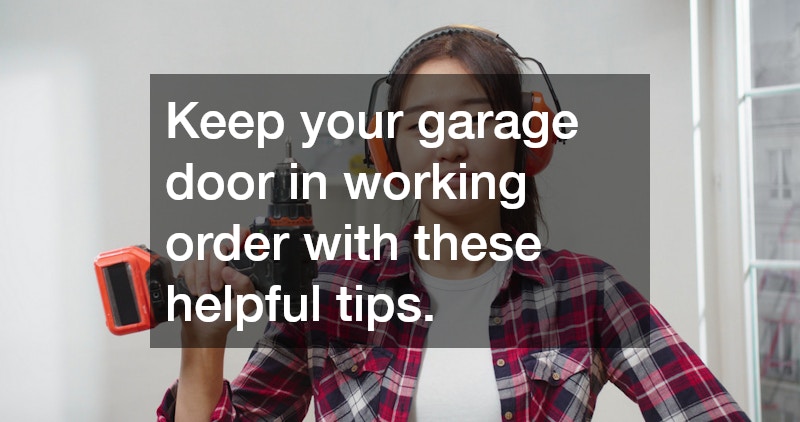Your garage door is one of the most frequently used components of your home, yet it’s often overlooked when it comes to maintenance. Whether you use it as your main entrance or simply for storage access, the garage door undergoes constant movement and exposure to the elements. Over time, this wear and tear can lead to performance issues, safety risks, and costly repairs if not addressed properly. Understanding the importance of regular maintenance ensures that your garage door operates efficiently, safely, and reliably for years to come. In this article, we’ll cover the key steps homeowners should take to maintain their garage doors, how often to perform them, and the benefits of hiring a professional garage door company for regular tune-ups.
What Are the Basic Maintenance Tips for Garage Doors?
Inspecting Hardware
One of the simplest yet most effective maintenance steps is to routinely inspect all the hardware that keeps your garage door functioning smoothly. The average residential garage door moves up and down more than a thousand times each year, which can loosen screws, bolts, and roller brackets over time.
Start by tightening any loose hardware using a socket wrench, especially on the tracks and mounting brackets. Inspect the rollers for cracks or chips—nylon rollers should be replaced every 5–7 years, while steel ones may last longer but require periodic lubrication. Pay close attention to the hinges as well; worn hinges can cause uneven door movement or additional stress on the opener system.
Lubricating Moving Parts
Lubrication is one of the most important steps in garage door maintenance. Proper lubrication reduces friction, ensures quiet operation, and extends the life of mechanical parts. Use a high-quality silicone-based or lithium-based spray lubricant—avoid using WD-40, which is more of a cleaner than a true lubricant. Apply the lubricant to the rollers, hinges, springs, and bearing plates at least twice a year. Be sure to wipe away any excess residue to prevent buildup, which can attract dirt and grime. Regular lubrication not only prevents squeaks and grinding noises but also helps the opener operate more efficiently.
Testing Balance
A properly balanced garage door is key to smooth operation and reduced strain on your opener. To test the balance, disconnect the opener by pulling the release handle (usually a red cord) and manually lift the door halfway. If the door stays in place, it’s balanced. If it moves up or down, the springs may need adjustment. Unbalanced doors place additional pressure on the opener, potentially shortening its lifespan or causing premature failure. While small adjustments can be made by experienced DIYers, it’s best to call a professional to safely adjust the tension in the springs, as they are under high pressure and can cause serious injury if mishandled.
Cleaning the Tracks
Dirt, debris, and rust buildup in the tracks can impede the smooth movement of the door. To clean them, first, remove any visible debris with a damp cloth or vacuum. Then, wipe the tracks with a mild household cleaner and a soft cloth—avoid using heavy grease, as it can attract dust and grime. Ensure the tracks are properly aligned and level; any gaps or bends can cause jerky movement or even derailment. If you notice significant misalignment, it’s best to have a professional technician inspect and adjust the track positioning.
Checking Safety Features
Modern garage doors are equipped with safety features that prevent accidents and injuries. The auto-reverse mechanism is one of the most critical. To test it, place a solid object such as a wooden block on the ground beneath the door and activate the close function. The door should automatically reverse once it touches the object. Additionally, test the photoelectric sensors located near the floor on either side of the door. Pass an object through the sensor beam while the door is closing—it should reverse immediately. If either test fails, clean the sensors and check for misalignment. A malfunctioning safety system should be repaired immediately to avoid potential hazards.
How Often Should I Perform Maintenance on My Garage Door?
Monthly Inspections
Conducting a quick visual inspection once a month helps identify issues before they become major problems. Look for frayed cables, rust spots, misaligned tracks, and worn rollers. Listen for unusual noises during operation—grinding, scraping, or squealing may signal mechanical wear or misalignment. Early detection allows for small, manageable fixes rather than large-scale repairs later.
Quarterly Balance Tests
Perform a balance test every three months to ensure the springs and lifting mechanisms are functioning properly. As mentioned earlier, an imbalance can lead to uneven movement and damage to the opener motor. Marking this test on your seasonal home maintenance calendar can help keep it consistent.
Bi-Annual Lubrication
Lubricating moving parts twice a year, typically in spring and fall, is sufficient for most climates. For regions with extreme weather, such as high humidity or freezing temperatures, you may want to increase frequency. Keeping the system well-lubricated helps it operate quietly and prevents unnecessary strain during seasonal temperature shifts.
Annual Professional Tune-Up
While DIY maintenance covers basic tasks, a professional tune-up once a year provides a thorough inspection and adjustment. A technician can test spring tension, align tracks, tighten hardware, and inspect the opener system for electrical or mechanical issues. They also perform safety checks to ensure compliance with manufacturer specifications. This annual checkup can prevent small issues from escalating into costly repairs or replacements.
Seasonal Weather Preparations
Weather changes can impact your garage door’s performance. In winter, cold temperatures can cause metal components to contract and stiffen, so ensure that moving parts are well-lubricated. In summer, humidity can cause swelling or warping in wooden doors—keep them sealed and painted to prevent damage. Adding weatherstripping around the edges of the door can help maintain insulation, reduce energy loss, and protect against water or debris entering your garage.
What Are the Benefits of Hiring a Professional for Garage Door Maintenance?
Access to Expertise
Professional technicians bring years of training and experience that go beyond what most homeowners can safely handle. They can quickly identify potential issues, such as fraying cables, worn torsion springs, or electrical malfunctions, and repair them correctly the first time. Their familiarity with various door brands and models ensures your system receives the appropriate care.
Time and Convenience
Garage door maintenance can be time-consuming, especially for busy homeowners. Hiring a professional saves you the hassle of researching parts, finding the right tools, and performing potentially risky adjustments. A qualified technician can complete a full maintenance check efficiently—often within an hour—allowing you to focus on other priorities.
Safety Considerations
Garage doors are heavy, and the tension in their springs poses serious safety risks. Attempting to adjust or replace these components without proper training can result in severe injury. Professionals have the necessary equipment and safety procedures to handle high-tension parts safely, ensuring that your system operates securely.
Quality Assurance
When you hire a reputable service provider, you can expect professional-grade tools, precision adjustments, and warranty-backed repairs. This quality assurance guarantees that your garage door system remains reliable and performs at its best long after the service visit.
Long-Term Savings
Regular maintenance helps you avoid expensive repairs or replacements in the future. By addressing small issues early—such as worn rollers or loose hardware you can prevent major system failures. A well-maintained garage door also consumes less energy, operates quietly, and maintains its appearance longer, protecting your investment over time.
Conclusion
Proper garage door maintenance is an essential part of homeownership that enhances both functionality and safety. By routinely inspecting hardware, cleaning tracks, testing safety features, and lubricating moving parts, homeowners can prevent premature wear and costly breakdowns. Establishing a regular maintenance schedule, monthly, quarterly, and annually, ensures consistent performance and reliability. While many basic tasks can be handled independently, scheduling professional tune-ups provides added peace of mind and long-term value. With consistent care, your garage door will continue to operate smoothly, securely, and efficiently for years to come, adding both convenience and curb appeal to your home.

